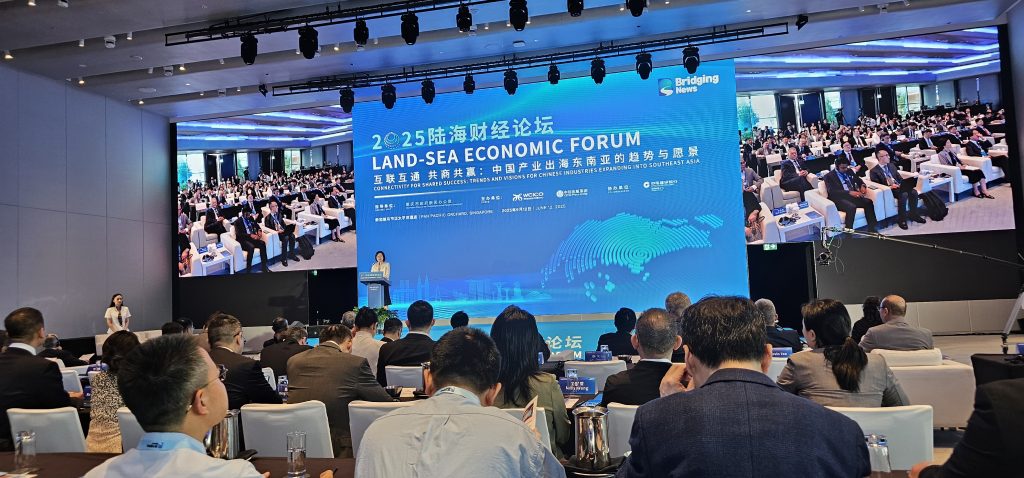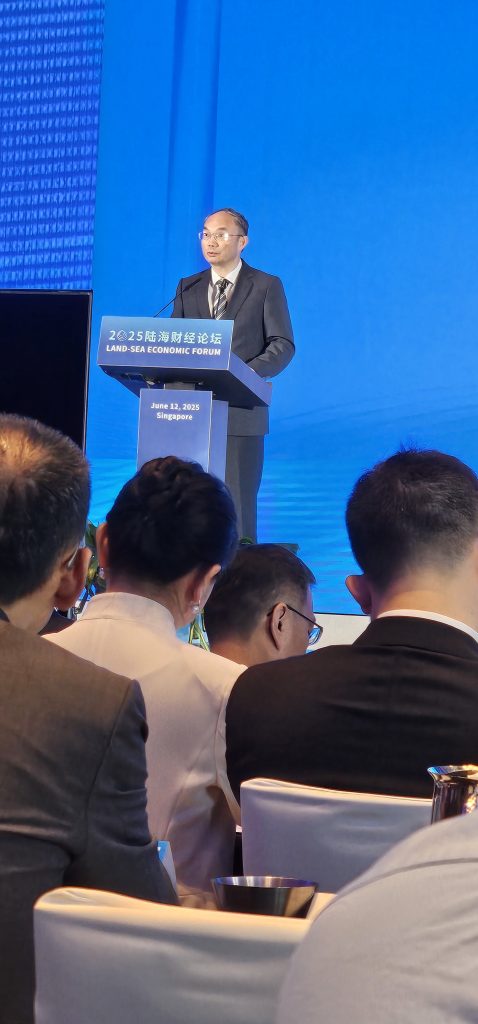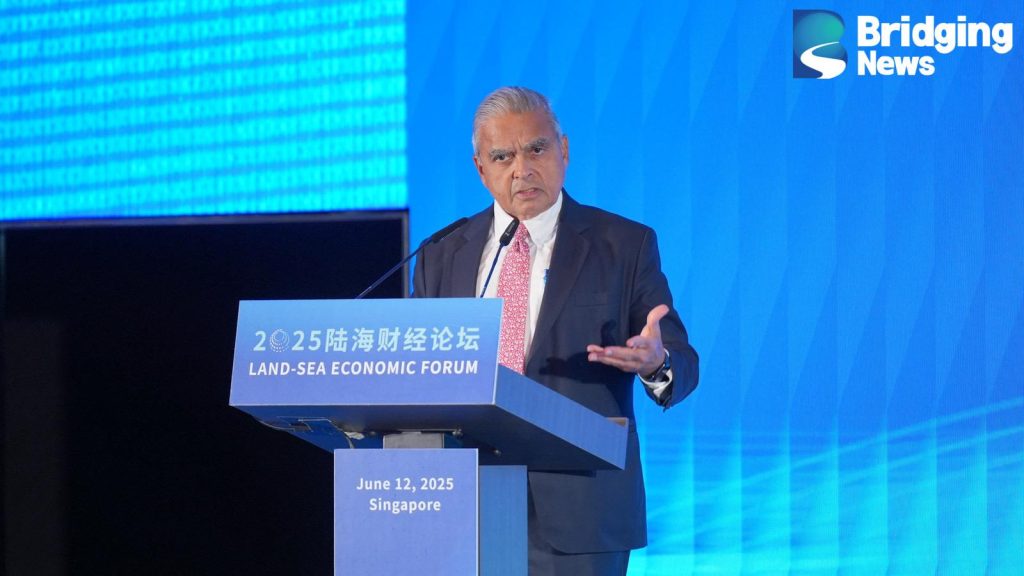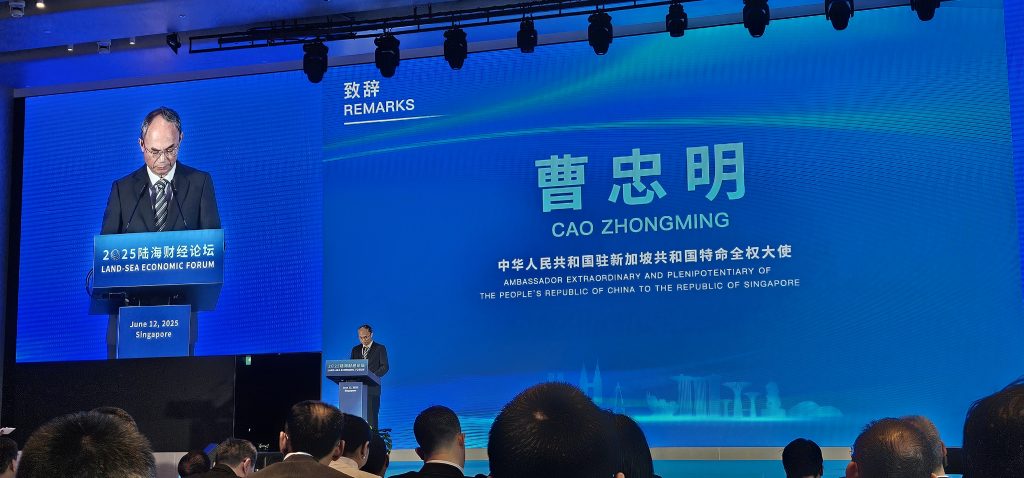
Photo: V.K. Santosh Kumar
Singapore, June 13, 2025: Connectivity, resilience and strategic cooperation took centre stage as nearly 200 policymakers, corporate leaders and academics convened at the 2025 Land-Sea Economic Forum in Singapore on June 12.
Under the theme “Connectivity for Shared Success: Trends and Visions for Chinese Industries Expanding into Southeast Asia,” the forum underscored the evolving dynamics of China-ASEAN economic ties in an increasingly protectionist global climate.
Hosted by the Chongqing Municipal Government alongside CITIC Press Group and WCICO, the event—originally planned for 120 attendees—saw over 170 delegates from China, Singapore, Malaysia and beyond gather at the Pan Pacific Orchard for a day of keynotes, reports and robust roundtable discussions.
Reinforcing Regional Links
In his opening remarks, Vice Mayor of Chongqing Xu Jian celebrated the 10th anniversary of the China-Singapore (Chongqing) Connectivity Initiative (CCI), noting Chongqing’s role as Western China’s economic fulcrum.
With robust growth in manufacturing and smart technology, he positioned the city as a launchpad for Chinese enterprises looking to scale across Southeast Asia.

Photo: V.K. Santosh Kumar
Echoing this sentiment, China’s Ambassador to Singapore, H.E. Cao Zhongming (right), emphasised the “shared destiny” of China and Singapore, citing deep cultural ties and complementary economic strengths.
He highlighted the Belt and Road Initiative’s reach, spanning 127 countries, and lauded the formalisation of the Free Trade Area 3.0, which promises to ease cross-border business and investment.
Shifting Global Trade Winds
A recurring theme was the stark contrast between the ASEAN-China partnership’s progress and mounting global trade barriers, especially from the US and EU.
Renowned Singaporean diplomat and NUS scholar Kishore Mahbubani (below), in a thought-provoking keynote, described today’s global landscape as “upside down.”
He recalled how four decades ago, the US championed free trade, but has since pivoted towards protectionism, shaking the foundation it once built.
Mr Mahbubani called for ASEAN and China to remain pillars of openness and connectivity. “In a world of closing doors, it is vital that our region keeps its doors open,” he urged, highlighting ASEAN’s unique achievement: maintaining peace and cooperation in the world’s most culturally diverse region for over half a century.
Investment Momentum & Localisation
He Dong, Chief Economist at ASEAN+3 Macroeconomic Research Office (AMRO), stressed that while China’s investment in ASEAN has doubled post-pandemic, it still constitutes under 10% of total FDI, pointing to massive untapped potential.
His “ASEAN+3 Regional Economic Outlook 2025” cautioned that protectionist tariffs could further dampen global growth, but emphasised the region’s policy flexibility to weather such headwinds.
One compelling case of China’s local integration was presented by Mr Guan Xin, Vice President of Changan Auto Southeast Asia. In May, Changan opened its first overseas new energy vehicle manufacturing plant in Rayong, Thailand. The company now operates 190 stores and partners with over 200 suppliers region-wide, supporting over 300,000 jobs, 87% of which are local hires. “Chinese automakers are shifting from exporting cars to exporting an entire ecosystem,” Mr Guan noted, describing regional supply chains as key to mitigating tariffs and geopolitical risks.
Digital & Cultural Bridges
China Securities’ Southeast Asia Investment Report 2025 released during the forum emphasised emerging opportunities in digitalisation, smart manufacturing, and services — sectors where Singapore and Chongqing stand as model hubs.
 Roundtable discussions revealed that AI and fintech are transforming cross-border e-commerce. Panellists from Tencent, Ant International and Advance Intelligence Group agreed that seamless cross-border payments are crucial to driving brand globalization. Another session on cultural exports highlighted that Chinese brands now prioritize local tastes and branding strategies to connect with ASEAN consumers more authentically.
Roundtable discussions revealed that AI and fintech are transforming cross-border e-commerce. Panellists from Tencent, Ant International and Advance Intelligence Group agreed that seamless cross-border payments are crucial to driving brand globalization. Another session on cultural exports highlighted that Chinese brands now prioritize local tastes and branding strategies to connect with ASEAN consumers more authentically.
Financial Connectivity for Expansion
A final roundtable, featuring senior leaders from China Construction Bank, the Asian Development Bank and the Singapore Exchange, explored how robust financial services and innovative capital market frameworks can underpin deeper China-Singapore and wider ASEAN integration. Participants noted that escalating tariffs have paradoxically driven more Chinese firms to invest directly in ASEAN markets, accelerating local partnerships and supply chain resilience.
 New Milestones & Shared Vision
New Milestones & Shared Vision
The day also witnessed the unveiling of initiatives like WCICO’s “Bridging News Singapore Station” and the inauguration of the CCB Singapore Vision Foundation, underscoring a shared commitment to knowledge exchange and sustainable growth.
Closing the forum, participants reaffirmed that in an era of economic uncertainty and trade fragmentation, China and ASEAN must double down on trust, openness, and innovation.
As Mr Mahbubani aptly summed up: “Few regions have proven that diversity can coexist with prosperity as ASEAN has done with China. May this partnership continue to be a beacon for the world.”












